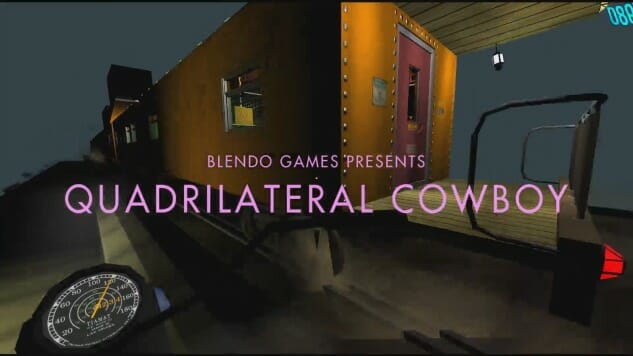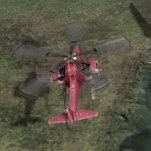Quadrilateral Cowboy: Hack, Steal, Eat Ramen

Blendo Games’ Quadrilateral Cowboy is a snapshot of the lives of three lifelong friends and professional hackers, Poncho, Lou and Maisy. It follows these three women as they perform a series of heists in an alternate version of the 1980s, with hoverbikes, cybernetic augmentations and space elevators. Quadrilateral Cowboy empowers me with a “top-of-the-line hacking deck armed with a 56.6k modem and a staggering 256k RAM” to pull off these heists. I spent much of my time in the game manipulating the world by typing lines of code. Quadrilateral Cowboy’s programming is a simplified version of actual coding that conveys both the rush of success from affecting the environment by simply typing on a computer terminal as well as the agonizing frustration of banging my head against a brick wall of code.
Quadrilateral Cowboy is split up into a series of heists, each one with multiple components in the form of puzzles. Every heist location and set piece feels unique: one you’re robbing a fancy villa, another level, a futuristic medical clinic, and another still a moving truck. Some of the set pieces are impressive far beyond what I would expect from a game created almost entirely by one person (Brendon Chung), such as one set on three parallel moving cable cars. Each cable car has something different you need to steal and a different means of entry, and all the while they accelerate upwards into the fog. And though the visuals seem simplistic at first, they instead come across as the aesthetic of this world. They are not a hindrance to the game’s experience but a unique means of presenting the genre of cyberpunk, which has been done in so many ways, but none that have looked like this, at least in my experience.
Quadrilateral Cowboy not only engages through its ever-changing heists, but through the way it incorporates some of the best parts of actual coding – the feeling of ingenuity and discovery that comes from reworking the world through simply typing on a computer. Pulling off the heists and solving the puzzles involves using the in-game computer terminal to manipulate security devices or your own gadgets, such as a computer-controlled rifle or a remote trigger to execute computer commands from afar. By typing commands, you can open a door, fire a gun, take over a security camera, and much, much more. Each heist gives a new way to interact with the world and then lets it reappear in future heists to compound with other new mechanics. Realizing how to combine the rifle with the augmentation to fire it remotely to open a timed door gave my synapses a rush as they connected to see the world in new ways through programming. As soon as the different gadgets and security manipulations have their moments, Quadrilateral Cowboy pivots laterally to find entirely new ways to approach heists. The mechanical density on display in Quadrilateral Cowboy is an antithesis to many larger, bloated games that stretch their core systems far too thin. Its determination to never let things become stale is admirable, even if it doesn’t always succeed.
Just as the sense of discovery I had when I first learned to program soon gave way to frustration and tedium as I stared at the same lines of code over and over again, so too Quadrilateral Cowboy had me staring at the same parts of levels over and over again, far past the point they stopped being enjoyable. Quadrilateral Cowboy punishes many slight mistakes by making you repeat the whole level over. The feeling of discovery that came with using new gadgets or mechanics in heists is replaced with frustration, or worse, boredom, as I’m forced to repeat rote actions. Aiming a gun to hit a target perfectly through a small open window felt great the first time. The fifth time I had to aim at that same target because I’d been forced to restart the level was maddening. And I would have to restart for mistakes that seemed as simple as forgetting a semicolon in my code. In the villa level, the second floor is blocked by a wall of lasers, which can be shut off by a button on the first floor. I was curious, so I shut them off and went upstairs. Except that once upstairs, the lasers reactivated and I had no way of getting back downstairs without tripping them. Furthermore, there was nothing upstairs of value to my current objective, but I didn’t know that beforehand. So when I went back downstairs, the alarm triggered and a security turret killed me. I had to restart the whole level. It felt like I had been punished for curiosity with tedium, and that was far from the only time.
-

-

-

-

-

-

-

-

-

-

-

-

-

-

-

-

-

-

-

-

-

-

-

-

-

-

-

-

-

-

-

-

-

-

-

-

-

-

-

-














































